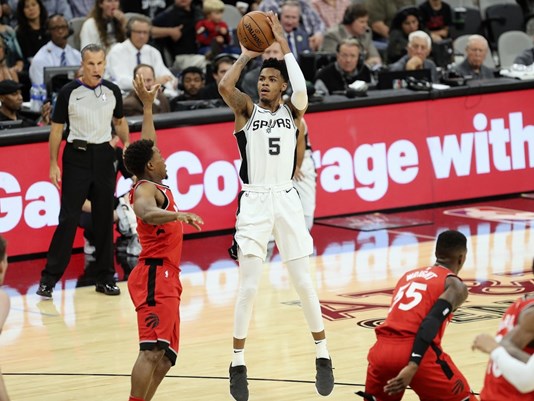With just over a week of regular season basketball in the books, the 2017-2018 NBA season is officially in full swing. Although the San Antonio Spurs have only played four games, the numbers provide insight into how the Spurs have been able to win each game they have played so far and potential areas of improvement.
Last season, nearly 26% of shots the Spurs attempted came from behind the 3-point line, good for 24th in the league. This season, while still young, the Spurs have actually dropped to a league-lowest 18.2 3-point attempts per 100 shots. The increase in 3-point shooting league-wide is a relatively new trend. In the 2013-2014 season, no team attempted more than 30% of their field goal attempts from behind the arc. Last season, however, 11 teams did. While the Spurs have been slow adapters to this style of play already, their approach to 3-point shooting seems to be even more extreme this season.
The main reason for this has been the LaMarcus Aldridge-centric offense. Early in this season, the Spurs have been utilizing an inside-out style of play in which they get the ball to Aldridge in the post early in the possession and allow him to read the defense and either attack the basket or pass to a cutter or a player on the perimeter.
Corner 3’s, of which the Spurs were early adopters in the early 00’s, are the shortest possible 3-point attempt in the NBA. One of the easiest ways to get open, high-quality looks from the corners is to have a solid shooter stand outside the 3-point line near the baseline on one side of the court and run the primary action of a set on the other. Once the offense is able to draw the defense’s attention towards the primary action and away from the shooter on the weak-side, they quickly rotate the ball to the shooter for what typically results in a fairly uncontested shot. An example of this type of play is the Spurs’ “Hammer” set, which Project Spurs’ own Paul Garcia outlined here.
When Aldridge has the ball in the post, however, there are usually two or three defenders between he and any teammate that would be in position for an open 3-point attempt on the weak-side. Getting the ball to that teammate would require either a risky pass from Aldridge or a series of passes that would take the ball out of the post and around the perimeter, giving the defense time to rotate. Last season the Spurs ranked 10th in the league in percentage of total shots attempted from the corners. Through four games this season, they rank 29th in that category.
The Spurs’ defense, however, has continued to be solid despite missing one of the league’s best perimeter defenders. The Spurs are currently ranked 5th in points allowed per possession and were ranked as high as 2nd before Wednesday night’s game against the Miami Heat, where they were not as strong defensively as they had been in the previous three games. Early this season, the Spurs have denied teams from grabbing offensive rebounds more than any other team in the league, helping them secure stops and denying opponents’ easy put-backs.
One area for defensive improvement, however, has been transition defense. The Spurs have allowed 1.25 points per transition play, ranking them 20th in the league. The Houston Rockets, Golden State Warriors, and Oklahoma City Thunder each rank in the top 10 in frequency of total plays being considered transition plays so far this season. If the Spurs match up against any of those teams in the playoffs, as they are projected to do if they make a deep run, transition defense may be one of the most important factors to win a series against any of those teams.
The Spurs have plenty of time to improve, however, and the imminent return of Leonard should provide a much need boost to both the team’s 3-point shooting and transition defense.
All stats obtained from CleaningtheGlass.com






